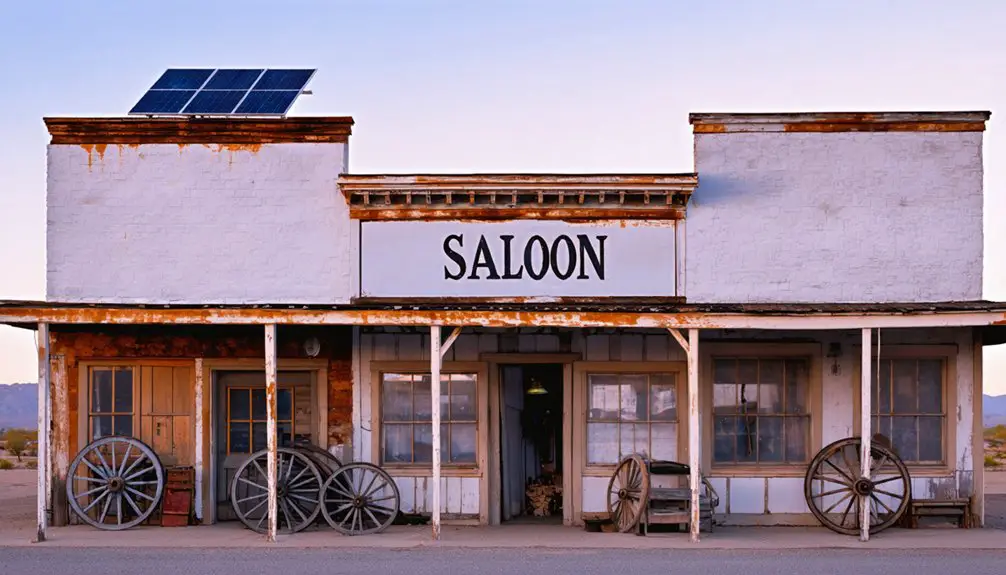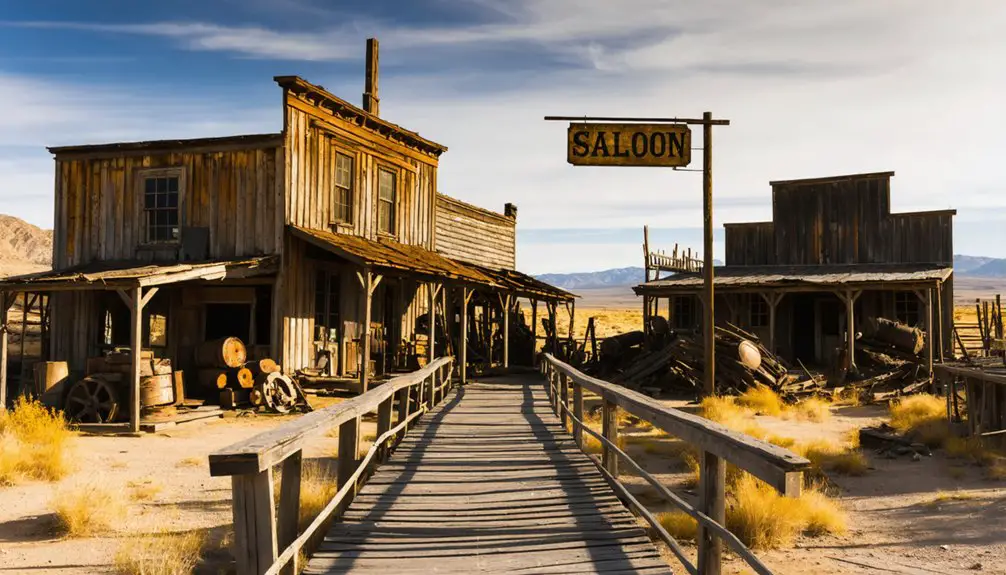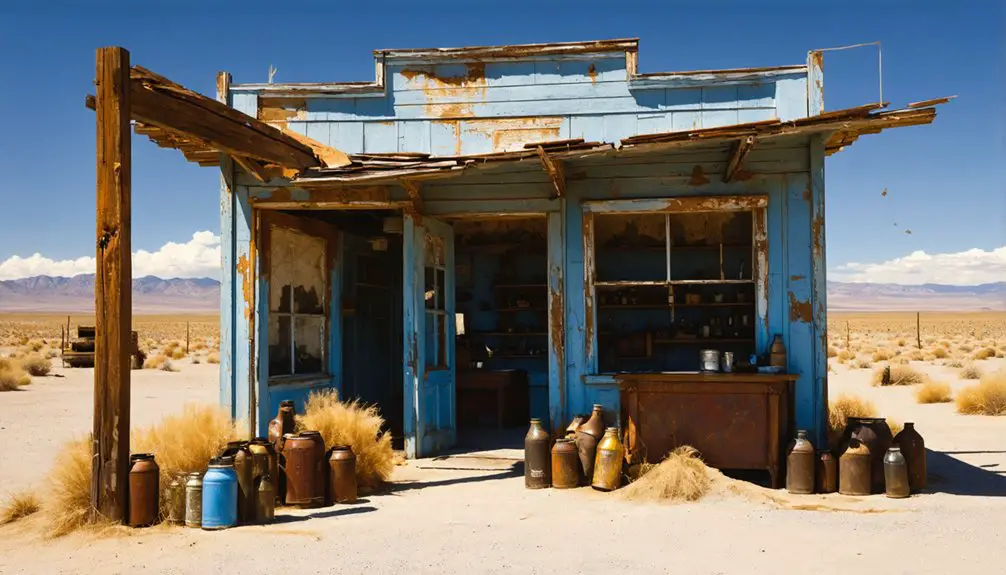You’ll find Chafey, formerly known as Dun Glen, nestled in northern Nevada’s Sierra Mining District. The settlement began in 1862 following a silver strike, quickly growing to become the region’s second-largest commercial center. Through boom-and-bust cycles, it transformed from Dun Glen to Chafey in 1908, reaching nearly 1,000 residents. Chinese miners contributed considerably to its success, extracting an estimated $4 million in minerals. Today, stone foundations and mill ruins tell a deeper story of frontier perseverance.
Key Takeaways
- Chafey emerged in 1908 as a revival of the former mining town Dun Glen, attracting approximately 1,000 residents during its peak.
- The town centered around silver mining operations, including the notable mines Tallulah, Auld Lang Syne, and Nevada Wonder.
- Chafey maintained its own post office from 1908 to 1911, serving as an important commercial hub for the Sierra Mining District.
- The settlement featured stone buildings, mills, and various amenities including stores, saloons, and a schoolhouse during its brief existence.
- Today, the ghost town site contains scattered stone foundations, mill ruins, and the historic Dun Glen cemetery.
The Birth of Dun Glen and Early Settlement
Following the discovery of silver in 1862, the town of Dun Glen emerged as a significant settlement in northern Nevada. The early settlers christened their new home after Angus Dun, a pioneering resident whose name you’ll find spelled various ways in historical records – Dunn, Dunn Glen, or Dunglen.
In 1862, Dun Glen rose from Nevada’s silver-rich earth, taking its name from pioneer Angus Dun.
Within just a year, you’d have found yourself among approximately 250 inhabitants in what quickly became northern Nevada’s second-largest commercial district.
As the town established itself, it naturally evolved into the heart of the newly formed Sierra Mining District. You would’ve witnessed the transformation of a simple mining camp into a thriving commercial center by 1863. A post office opened in July 1865, marking the town’s growing importance.
The settlement’s strategic importance was cemented as it became the primary business hub, supporting the burgeoning mining operations throughout the surrounding region. Early settlers faced challenges as tensions rose during conflicts with Piute tribes.
From Silver Strike to Boomtown
The year 1908 marked a dramatic revival in Chafey’s mining fortunes when prospectors uncovered rich silver deposits near the old Dun Glen site. E.S. Chafey’s discovery of the “Black Hole” property transformed the area into a bustling boomtown, attracting nearly 1,000 freedom-seeking residents – four times larger than Dun Glen’s peak population.
The settlement’s rapid growth exemplified classic boomtown dynamics, with entrepreneurs quickly establishing commercial ventures on the former Dun Glen townsite. Local newspaper articles frequently covered the Dun Glen Mines operations, highlighting their significance to the region.
- Four daily stagecoach runs connected Chafey to Mill City, facilitating trade and movement
- Silver mining operations incorporated stamping mills and amalgamation processes
- The post office operated under the Chafey name from 1908 to 1911
This vibrant period of silver mining prosperity lasted until 1913, when depleted ore deposits led to the operation’s closure and the town’s eventual abandonment.
Life in a Frontier Mining Community
While silver drew fortune-seekers to Chafey’s rugged terrain, daily life in this frontier mining community proved both diverse and challenging.
You’d find a multicultural mix of Anglo-American and Chinese miners working the area’s rich deposits, each group adapting to frontier challenges in their own way. Chinese miners focused on placer deposits in nearby canyons, while others operated the town’s three stamp mills.
Early settlers faced hostile encounters with the Piute Tribe, leading to military protection between 1863-1866 during the Snake War.
Despite these obstacles, communal resilience emerged through bustling saloons, stores, and a stagecoach service connecting Chafey to Mill City.
The community’s social fabric, though transient, supported miners and their families through boom-and-bust cycles that defined life in this Nevada mining town.
Military Presence and Local Conflicts
Mounting tensions between settlers and Native American tribes prompted the U.S. Army to establish a garrison at Dun Glen in 1863. The military strategy focused on protecting mining operations during the Snake War, with Company B, 2nd Cavalry Volunteers stationed six miles from Mill City.
Under Colonel Edward McGarry’s command, troops conducted essential scouting missions to secure overland routes and mining districts. The Auld Lang Syne mine received particular attention from the military due to its economic importance to the region.
Colonel McGarry led military patrols to protect vital mining regions and transportation corridors during the frontier’s expansion.
- Captain Thacker, a former Wells Fargo detective, led controversial frontier conflicts against the Paiute tribe, including a dawn raid resulting in twenty casualties.
- The garrison’s presence helped the Sierra Mining district grow to 250 residents by 1863.
- Military protection continued until August 1866, when declining mining activity reduced the post’s strategic importance.
The garrison’s establishment reflected the broader pattern of militarized responses to Native American resistance against mining incursions throughout the region.
Mining Operations and Economic Growth
Following silver’s discovery in 1862, Dun Glen rapidly emerged as northern Nevada’s second-largest mining settlement, reaching 250 residents by 1863.
You’ll find that mining technologies evolved from basic stamp mills to sophisticated operations using jaw crushers, ball mills, and Wilfley tables.
The town experienced dramatic economic fluctuations, first declining to 50 residents by 1880, then resurging in 1908 when E.S. Chafey’s mining venture attracted 1,000 people.
During peak periods, three stamping mills processed silver ore from prominent mines like Tallulah, Auld Lang Syne, and Mayflower.
The Nevada Wonder mine proved particularly lucrative, paying over $1.5 million in dividends.
Though Chinese miners attempted placer and drift mining in nearby canyons, water table challenges limited their success.
Initial lots in the bustling mining town sold for just $25 per plot, though property values later increased twentyfold.
The Chinese Mining Era
After the initial mining boom subsided in 1880, Chinese miners emerged as essential operators in Dun Glen’s mineral extraction industry, focusing primarily on placer deposits throughout Auburn, Barber, and Rockhill Canyons.
Their mining techniques, particularly drift mining, proved vital in adapting to challenging conditions like high water tables. Despite facing social and legal barriers, Chinese contributions to the region’s mining economy reached an estimated $4 million before 1900.
- You’ll find evidence of their ingenuity in the extensive milling infrastructure they operated, including stamp mills and amalgamation plates.
- They persisted through environmental challenges, working previously abandoned claims and managing complex water systems.
- Their mining settlements maintained local economies well into the 20th century, with operations continuing through the 1930s and 1940s.
Revival and Transformation Into Chafey

The 1908 discovery of silver at the Black Hole Mine near the old Dun Glen site sparked new life into the dormant mining district. E.S. Chafey established new operations, transforming the area into a bustling hub of economic activity. The town, renamed Chafey in his honor, quickly attracted 1,000 residents.
You would’ve found multiple saloons and stores in the revitalized community, with stagecoaches running four times daily between Chafey and Mill City. A post office opened on August 4, 1908, supporting the town’s growth. The town had ambitious plans to construct an electric plant and opera house, though these dreams never fully materialized.
However, the revival proved short-lived. By 1911, the post office reverted to the Dun Glen name, and mining operations ceased around 1913. Like many Nevada boomtowns, Chafey’s prosperity faded as quickly as it emerged, leaving behind another ghost town in the Silver State.
Daily Life and Infrastructure
You’ll find that Chafey’s daily life centered around a bustling commercial district that included saloons, stores, hotels, and a meeting hall where residents gathered for community functions.
The town’s infrastructure supported crucial services through a post office that operated from 1908 to 1911, while the educational needs of local families were met by a schoolhouse facility. Chafey became an important shipping point location for the region until its decline in the 1920s.
Your transportation needs would have been served by a robust stagecoach system that made four daily trips between Chafey and Mill City, connecting residents to essential supplies and services.
Community Amenities and Services
During its heyday, Chafey maintained a robust network of crucial amenities and services centered around its mining economy.
You’d find bustling retail competition among stores and saloons, particularly during the 1863 and 1908 boom periods. The town’s vibrancy showed in its community gatherings at local meeting halls and hotels, where residents connected and conducted business.
- You could send and receive mail at two different post offices – Dun Glen (1865-1894) and later Chafey (1908-1911)
- You’d have access to four daily stagecoach runs to Mill City, connecting you to the Central Pacific Railroad
- Your children could attend the local school while you shopped at various supply stores
The town’s infrastructure supported nearly 1,000 residents at its peak, with crucial services like foundry access in nearby Mill City and multiple stamp mills for ore processing.
Town Layout and Buildings
Originally centered around Dun Glen Creek, Chafey’s layout evolved from a plotted town site established after the 1862 silver discovery into Nevada’s second-largest northern commercial district by 1863.
The town planning reflected both mining operations and residential needs, with structures clustered near the creek and mining zones. You’ll find evidence of varied architectural styles, from basic dugouts to substantial stone cabins featuring thick walls and fireplaces. The impressive stone cabin includes an arched fireplace that stands as a testament to the skilled craftsmanship of the era. Like other ghost towns of the period, many buildings were carefully stabilized with internal framing while preserving their original exterior appearance.
Commercial buildings and saloons dominated the district, while miners’ housing spread outward from the center. The town’s infrastructure included three stamp mills, with buildings typically constructed using 1×12 inch boards set on stone foundations.
Military presence influenced building placement, while stage lines connected Chafey to Mill City with four daily runs, supporting the town’s commerce and transportation needs.
The Final Days of a Mining Town

Despite the promising silver rediscovery in 1908 that briefly revitalized the area, Chafey’s existence as a mining town proved short-lived.
Like many Western mining towns, Chafey’s silver dreams sparkled briefly before fading into the desert dust.
You’ll find that by 1913, the once-bustling community of 1,000 residents rapidly transformed into a ghost town when mining operations ceased. The final days came swiftly as both businesses and residents abandoned the area following the closure of mining operations.
- The post office’s shutdown on April 15, 1913, marked the official end of Chafey’s brief but vibrant era.
- Unlike its predecessor Dun Glen, Chafey’s boom-to-bust cycle happened in just five years.
- While sporadic mining attempts continued throughout the 20th century, you’d never again see the town return to its former glory.
The area’s economy shifted primarily to ranching, though intermittent mining persisted into the 2000s.
Modern Remnants and Historical Legacy
While most buildings have succumbed to time, Chafey’s physical remnants tell a compelling story of its mining era through scattered stone foundations, mill ruins, and the enduring Dun Glen cemetery.
You’ll find deteriorated stamp mills and mining trails that trace the town’s industrial heritage, while the cemetery stands as the most intact cultural preservation site, despite facing vandalism and relocation challenges over the years.
Today, you can access the ghost town via paved roads, where you’ll encounter feral donkeys and opportunities for night photography. The site attracts historical exploration enthusiasts seeking to document and understand Nevada’s mining past.
The site exemplifies Nevada’s boom-and-bust mining culture, drawing ghost town tourism enthusiasts who explore the quiet landscape.
Though minimal development exists, the remnants serve as powerful reminders of Western mining history, immigrant experiences, and Native American conflicts that shaped this once-bustling community.
Frequently Asked Questions
What Animals Roam the Ghost Town Area Today?
You’ll spot antelope, cattle, and wild donkeys through wildlife sightings and animal tracks, while coyotes, jackrabbits, hawks, lizards, and rattlesnakes make their home among the ruins.
Are There Any Documented Paranormal Activities in Chafey’s Ruins?
You won’t find explicit documented ghost sightings in Chafey’s ruins, though its haunted history of mining accidents, grave disturbances, and conflicts with Native Americans fuels local legends about paranormal activity.
What Is the Nearest Modern Town to Chafey’s Location?
Mill City is your closest modern town to reach this ghost town’s ruins, sitting about 9 miles southwest. You’ll find basic modern amenities there before exploring the more remote location.
Can Visitors Legally Collect Artifacts From the Ghost Town Site?
No, you can’t legally collect artifacts from this site. Legal restrictions protect historic and cultural materials under federal and state preservation laws. You’ll face penalties if you remove items without permits.
What Was the Average Temperature and Weather Like in Chafey?
You’ll experience cold winters around 28°F and hot summers up to 93°F. The historical weather showed a semi-arid climate with limited rainfall, moderate winds, and wide daily temperature swings.
References
- https://kids.kiddle.co/Dun_Glen
- https://en.wikipedia.org/wiki/Dun_Glen
- https://www.nevadaghosttownsandmininghistory.com/portfolio-2/dun-glen
- https://www.destination4x4.com/list/pershing-county-nevada-ghost-towns/
- https://nvtami.com/2022/09/26/dun-glen-the-not-so-final-final-resting-place/
- https://www.destination4x4.com/dun-glen-nevada-pershing-ghost-town/
- http://www.nv-landmarks.com/towns-de/dunglen.htm
- https://ronhess.info/docs/report7_history.pdf
- https://forgottennevada.org/sites/dunglen.html
- https://www.nvexpeditions.com/pershing/dunglen.php



